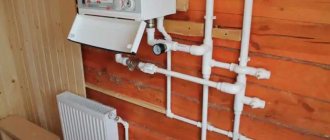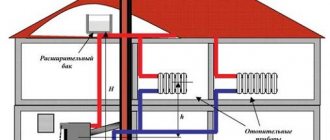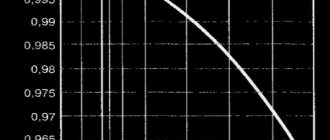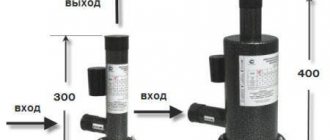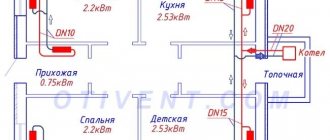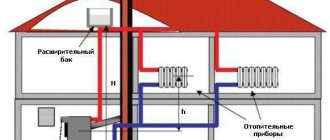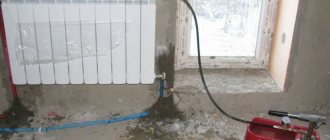How does an open heating system work?
There is no need to install a pump to start the system. The coolants are constantly in a closed system, so there are no losses. Installation of the heating system is so simple that it does not require special skills.
Open heating system
What are the main parts of the system?
- Gas or solid fuel boiler. The consumer can choose the best option that meets the desired requirements;
- Heating radiators. You can make your choice in favor of either cast iron or steel;
- Expansion tank made of steel;
- Pipes.
How does an open heating system work?
The first step is to heat the water in the boiler. Hot water then flows under pressure into the pipes and reaches the low pressure zone. After the hot water makes a complete whirlpool and gives off heat, it returns to the starting point - the boiler. Due to the fact that water expands under the influence of high temperatures, an expansion tank is required in the system. It acts as a compensator for excess water volume. The tank is an object that is not sealed hermetically. To make it easier to start the heating system, it is necessary to install a mortise tap. With its help, air is removed from the system. The operating principle of an open heating system is divided into two stages:
- "Innings". The water is heated, flows through pipes into radiators and heats the room;
- "Treatment". The cooled water from the radiators is returned through the pipes to the boiler.
Features of the arrangement of an open heating system:
Be sure to place the expansion tank above the level of other heating system devices;
Choose water rather than antifreeze as the coolant; Since water can evaporate when heated, it is important to monitor its level in the boiler and replenish reserves in a timely manner.
System using forced circulation principle
Scheme using a pump.
In fact, this system is not much different from the natural one. The difference is that in this case the slope of the pipes is needed at the bottom, and to circulate the coolant, a pump is used, installed at the point before the cooled water enters the boiler.
The main advantage of this method is that there is no need to create a slope; the coolant moves due to the circulation pump.
This system is effective because the flow rate is higher than with natural circulation, and accordingly the room heats up faster. At the same time, the operating costs of a gas heating boiler are lower.
This scheme is used in houses of any size. You just need to choose the right pump according to power.
But this solution also has disadvantages - installation of the pump and subsequent work will require connection to the electrical network. And if there is no voltage in the network, the heating will not work. Therefore, the owner of a home where forced circulation is used needs to take care of an uninterrupted source of electricity, because in Russia there are regular problems with energy supplies.
Schemes for water heating in a private house
To heat cottages, heating systems with water as a coolant are installed, consisting of:
- water heating boiler (single-circuit or double-circuit);
- pipelines and fittings (metal or polypropylene);
- bypasses that allow you to disconnect individual heaters from the network;
- batteries (cast iron, aluminum, steel and bimetallic);
- expansion tank.
Gas heating units are equipped with a specific safety system, including a solenoid valve and a thermocouple. The devices are connected to each other by wires. If the heating unit is functioning normally, the thermocouple junction is heated by the igniter. At this time, current flows freely through the winding of the solenoid valve, which ensures the open position of the valve. When the thermocouple cools down, the gas access is blocked by an electromagnetic valve.
According to the battery connection diagram, they are single-pipe and double-pipe. In the first case, water is supplied and discharged from the radiator using one pipe. In the second, the heating device is connected to two separate pipelines (supply and return).
Heating pipes to the radiators can be connected in a bottom, top, side or diagonal pattern
Heating circuits, based on the principle of water movement in pipes, are available with forced and natural circulation. When installing the second option, the coolant circulates in the system due to convection and gravity. And the forced scheme involves the installation of a circulation pump.
To ensure normal operation of a system with two or more circuits connected to the manifold, it provides for the installation of a hydraulic arrow. The hydraulic arrow eliminates pressure drops and the possibility of water hammer.
The expansion tank can be open or closed (divided inside into two parts by a sealed membrane). For gravity heating systems, an open option will be sufficient. A closed tank is designed for forced circulation circuits.
When using an open expansion tank, the water is saturated with air, so that this does not become a problem, the system should be supplemented with an air removal circuit
For small cottages, the natural principle of water movement will be sufficient. However, if a residential building has two or three floors, then you cannot do without a pump. The length of the circulation circuit in the first scheme is limited to 30 meters. The boiler will not be able to “push” water over a greater distance.
With natural circulation of the coolant in the gas heating circuit of a private house, there is no pump. If the boiler is chosen to be non-volatile, then the entire heating system is independent of the power supply. There are simply no elements that consume electricity.
On the one hand, it is more stable in operation, but on the other, the quality of heating in it is lower (the water reaches the radiators farthest from the water heater when it is very cold). The latter especially applies to pipelines and batteries made of steel or cast iron. These materials have high hydraulic resistance, which reduces the coolant current.
In addition to using standard radiators in a country house, you can organize gas heating using “warm floors” (+)
It is also possible to organize a combined heating system. In it, the circulation pump is connected to the main line through a bypass. If it is necessary to quickly warm up the air in the rooms, it is turned on to accelerate the water circulation. In other cases, it is cut off from the main pipe by shut-off valves, while the system continues to function in a natural (gravitational) mode.
Gas heating schemes for a house
We will talk about water heating using gas. You should immediately decide on the type of coolant circulation. It can be natural (such systems are also called gravitational) or forced (with a mandatory pump).
Gravity systems require the installation of large-diameter rubles, that is, there is a lot of coolant in the system. The second point is that due to the fact that the coolant moves through the pipes at a low speed, the heating efficiency is not very high. Distant radiators in long branches can be cold. It's about the shortcomings. There are many of them, but there is one big advantage - systems with natural circulation do not depend on electricity. This is important in regions where the power is often turned off.
Scheme of a natural circulation system
Now a little about forced circulation systems. They are more efficient - the coolant moves at a given speed, delivering heat to all corners of the system. The presence of a pump allows the use of pipes of small diameters. This means that there is not much coolant in the system and it warms up quickly. In general, they provide a greater level of comfort, but have a serious drawback - they require electricity to operate, meaning they require backup power. If the light is rarely turned off, it is enough to install an uninterruptible power supply with several batteries. They can ensure the boiler operates for tens of hours. If the lights are turned off often and for a long time, you will also have to build a generator into the system. In any case, these are additional costs and considerable ones.
There are also combined systems - they are designed as gravity, but have a built-in circulation pump. This solution can be called ideal from a practicality point of view: as long as there is light, the heating works as forced heating, as soon as the power supply is lost, everything works as a gravitational system. In general, a good option, except that the pipes will be large and too visible.
Wiring method
There are three types of systems - single-pipe, double-pipe and beam. In single-pipe radiators, they are connected in series to one pipe. This wiring method is economical - fewer pipes are required, but it is difficult to compensate for it - it is difficult to achieve the same heat transfer from radiators. The thing is that the coolant enters the first radiator in the branch hot - straight from the boiler. It passes through it, cools a little, goes to the next one, cools a little more. So throughout the entire thread.
Scheme of a single-pipe gas heating system for a private house
It turns out that the coolant that reaches the last radiator is much colder than the first one. The only way out is to take this phenomenon into account when designing the system and increase the number of sections in the radiator as it moves away from the boiler. But the last radiators will still remain the coldest.
You can more or less easily balance the system shown in the photo above. It contains thermostats on each radiator - devices that allow you to change the amount of coolant passing through the radiator. In order not to “crush” the circulation in the entire system, a bypass is placed under each radiator - a jumper along which coolant flows that did not go through the radiator.
In a two-pipe system, radiators are connected in parallel - to the supply and return pipelines. In this system, the pipe consumption is much greater, since two threads are pulled at the same time. But in this case, each heating device is supplied with a coolant with the same temperature, due to which the heat transfer from the radiators will be the same (if the same batteries are installed).
Example of a two-pipe circuit
In this scheme, you can also install thermostats, but this does not require bypasses - only the flow to one radiator is regulated. So despite the higher pipe consumption, two-pipe systems are more popular.
The beam wiring method is the most expensive in terms of the number of tubes. In them, each radiator has a separate supply and return pipe. It connects to a collector - a device with one input and several outputs. In this case, adjustment is possible both on the manifold and on the radiator using a thermostat.
Radial heating wiring diagram
Gas heating of a private house made according to this scheme will be the most reliable: if one of the pipelines is damaged, all the others will work. Therefore, this method is often chosen if pipes are hidden in a screed.
Water heating
Undoubtedly, when asked what types of heating there are, it is water heating that first comes to mind. Water heating has the following advantages:
- Not very high surface temperature of various devices and pipes;
- Provides the same temperature in all rooms;
- Fuel is saved;
- Increased service life;
- Quiet operation;
- Easy to maintain and repair.
The main component of a water heating system is the boiler. Such a device is necessary to heat water. Water is the coolant in this type of heating. It circulates through closed pipes, and then the heat is transferred to various heating components, and from them the entire room is heated.
Components of water heating
The simplest option is natural circulation. This circulation is achieved due to the fact that different pressures are observed in the circuit. However, such circulation can also be of a forced nature. For such circulation, water heating options must be equipped with one or more pumps.
After the coolant passes through the entire heating circuit, it is completely cooled and returned back to the boiler. Here it heats up again and thus allows the heating devices to produce heat again.
Classification of water heating systems
Water heating type may vary according to criteria such as:
- water circulation method;
- location of distribution lines;
- structural features of risers and the diagram according to which all heating devices are connected.
In a pump heating system, heating of the coolant can also take place thanks to a hot water boiler room, or thermal water that comes from a thermal power plant. In a heating system, water can even be heated by steam.
Water heating with circulation pump
The disadvantage of direct-flow connection is the dependence of the thermal regime on the “impersonal” temperature of the coolant in the external-type supply heat water.
Features and Benefits
Heating systems differ in the configuration of the expansion tank - a special container that compensates for the thermal expansion of the coolant. An open tank is installed in a gravity system - the liquid moves through the pipes without installing a circulation pump for heating. The coolant moves due to the natural circulation of the medium, which changes density when heated and under the influence of gravity.
A feature of a closed system is the use of a closed expansion tank, which is a sealed container equipped with an elastic membrane inside. This ensures efficient operation under pressure and eliminates contact of liquid with air.
Internal structure of closed expansion tanks
With forced circulation
A closed-type heating system in a private house may include a circulation pump that forces the coolant to actively move, maximally warming up all heating devices or the heated floor circuit.
A closed heating system with forced circulation has a number of advantages
:
Heating of a liquid under pressure occurs faster; the risk of airing of the pipeline and radiators is reduced; evaporation of the coolant (which is especially important when using antifreeze) and the penetration of oxygen into the liquid, which provokes corrosion of the metal elements of the system, are prevented; due to the installation of the membrane tank below next to the boiler, and not at the top point of the circuit, as in open systems, installation and maintenance are simplified; the movement of liquid under low pressure simplifies the calculation and installation of the pipeline - unlike a gravity system, in this option there are no strict requirements for the angle of inclination of the pipes and pipes of smaller diameter can be used; there is no need to use large-diameter pipes and install them in an open manner in order to have access to any part of the system to eliminate air pockets.
Example with an induction boiler
The heating system of a private house with a circulation pump and a membrane expansion tank provides better heating of the premises compared to gravity. But it has one significant drawback - energy dependence. The operation of the pump requires electricity, so this option is not suitable for buildings in remote areas with insufficient power supply or its complete absence.
With natural circulation
The gravity heating system is energy independent, and this is its advantage. Typically this is a heating system with a solid fuel boiler or stove; liquid fuel units are less commonly used.
Heating without a pump is suitable for a home with a relatively small area; it is important to correctly calculate the diameter of the pipes for each part of the system and design their installation scheme, observing the optimal angle of inclination of the pipeline sections. It is necessary to reduce the risk of airing and ensure efficient movement of coolant
A circulation pump can be added to a closed heating system with natural circulation at any time, increasing its efficiency. This is the best option for areas where there are problems with power supply. In this case, if there is a temporary lack of electricity, the house will not be left without heat - a closed-type system in a private house will work like a gravitational one.
Natural circulation
Basic wiring diagrams
Heating schemes for a private house with a wall-mounted gas boiler are divided according to several parameters:
- by type of wiring - single-pipe, double-pipe, radial;
- in direction – vertical and horizontal;
- by the number of circuits - one (heating) or two (heating and hot water supply);
- by type of circulation - forced or natural.
Single/double-pipe, beam - pros and cons
The single-pipe heating scheme for a private house with a wall-mounted gas boiler is the simplest: one pipe, which extends from the boiler, bypasses all the heating devices in turn and delivers the already cooled coolant to the boiler. In a two-pipe system, a second pipe is provided for return (cooled coolant).
The first option is used in houses with a small heated space, as well as in technical buildings - garages, etc., because When all batteries are sequentially bypassed, the coolant cools down, the heating of the devices at the beginning and end of the circuit is different.
This problem can be partially solved by installing control valves on radiators: less hot coolant is consumed at the beginning of the route, the main flow goes further.
The advantages of this system: simple installation, minimum connections, easier calculation of hydraulic pressure. Minus: the inability to turn off part of the circuit (for example, in the utility room) when there is no need to heat this room.
With two-pipe wiring, the house warms up more evenly. The use of control taps allows you to achieve an almost ideal temperature balance between different zones. Cons - this system is more complicated and more expensive.
The best option for a spacious cottage is radial wiring. This implies the presence of at least one collector unit, from which each device has its own hot pipe. The downside is that this system is the most expensive and difficult to install.
Pros - the coolant enters each device hot, and when using control valves installed directly in the collector unit, it is also heated to the required condition. When installing heated floors, separately or in combination with radiators, only radial wiring is used.
Features of solid fuel boilers
Gas supply and centralized electricity supply are still not available everywhere in Russia. Gas is cheap only in capital cities, and even there it is becoming more expensive. Electricity is expensive everywhere.
Communication networks leave much to be desired: power outages and sudden voltage changes are commonplace outside the city. It is not always possible to connect to the main gas, and purchasing liquefied gas in cylinders is an energy-intensive business.
Heating with a solid fuel boiler has several advantages:
- you can choose the type of fuel that is cheapest in your area - firewood, peat, coal, wood waste, etc.;
- solid fuel boilers are the cheapest in the category. Long-burning models are more expensive, but their thermal efficiency is higher;
- a large assortment. Automation and auxiliary strapping elements can be purchased separately if necessary;
- Unlike gas units, the installation of a solid fuel boiler does not require permission from the local administration.
Now about the cons:
- fire hazard. But both gas and diesel models have this drawback. And in case of problems with wiring - even electrical ones;
- the need to monitor the amount of wood/coal in the firebox. A solid fuel boiler cannot be simply “turned on and forgotten”. It is less often necessary to add fuel to pellet and long-burning boilers, but in this regard they are not very autonomous;
- The combustion process of solid fuel is difficult to control (for other units it is enough to turn off the gas valve or turn off the electricity). The inertia of solid fuel boilers is high, and so is the entire system.
Solid fuel boiler design
https://youtube.com/watch?v=MY-xodMMyDI
Heating scheme
The circulation of water through pipes and radiators occurs due to the upward movement of the heated liquid, as well as from the operation of the circulation pump.
Additional items:
- Shut-off valves (the more taps there are, the easier it will be to maintain and repair heating elements).
- Air vents (oxygen, which gradually accumulates in pipes, is destructive to metals; it must be vented periodically).
- Thermostat (needed to keep the temperature in the rooms at the same level, saves fuel).
Installation of a floor-standing gas boiler in an existing heating system
An expansion tank is a mandatory attribute of any system. It can be closed or open. The closed one is paired with a circulation pump. An open tank is placed as high as possible, for example, in the attic of a house.
Pipe routing
- Single-pipe.
- Two-pipe.
Single-pipe. A pipe extends from the boiler to which radiators are connected in series. The further away the radiator is from the heater, the colder it is. This scheme is the simplest and requires few materials. But it is only suitable for small houses where the coolant will not have time to cool down. In addition, the system cannot be adjusted.
Two-pipe system - all radiators are connected to the supply pipe in parallel. Each one receives the first, hot water. After passing through the battery, the water flows into the return pipe and returns to the boiler. The system is a little more expensive, but all rooms are heated evenly. Suitable for multi-room houses.
Single-circuit or double-circuit boiler - it does not matter when choosing the type of wiring.
Connecting radiators
There are three options for connecting heating radiators:
- Unilateral.
- Lower.
- Diagonal.
They differ not only in location, but also in efficiency.
Let's look at each of these options in more detail:
- One-sided option. The supply and return pipes are located on one side of the radiator. The method saves materials, but is not very effective if the radiator consists of a large number of sections (the coolant simply cools down while it reaches the last section).
- Bottom option. Outdated and ineffective (radiators give off 15–30% less heat than they could). The liquid flows where it is easier - along the bottom of the heating devices, and the upper part remains unused.
- Diagonal option. The most correct. The water enters at the top of one side of the radiator, and, having passed through the entire battery, comes out at the bottom on the other side. This installation is required for long heating appliances. With such a scheme, you can expect that the radiators will give out the passport indicators.
All radiators are universal and have 4 possible connection points. This means that the connection method depends only on your desire.
Chimney
One of the prerequisites: the boiler outlet pipe must exactly match the diameter of the chimney. Other subtleties:
- The chimney from the boiler to the head should not have more than three bends.
- There should be no connections where the pipe passes through the wall or roof.
- The pipe must be insulated in places where it passes through an unheated room.
To check whether the length of the chimney you are planning will be sufficient, perform a simple calculation. Find the volume of the chimney and the volume of the boiler. The boiler must completely “fit” into the chimney. The area S of a round pipe is determined by the formula πR2. To find out the volume, multiply the resulting number by the total length of the pipe.
Conclusion. Having studied all the intricacies and carefully thought through everything, you can proceed to installation work. Remember that connecting the boiler to the gas mains should only be carried out by gas service specialists. They are also conducting a test run of the system.
Types of single-circuit heating
There are several classifications of single-circuit heating systems depending on various parameters. Initially, the main types of systems should be identified:
- open;
- closed.
Since water has a fairly high coefficient of expansion when heated (0.3% due to an increase in temperature every 10 degrees), it is necessary to compensate for the increasing volume of coolant so that the pipes are not damaged and an accident is avoided. Compensation is usually carried out through an expansion tank into which a polymer membrane is inserted. This membrane is elastic and, under the influence of increasing water volume, fills the tank completely.
The use of such membrane tanks is typical for closed, fully automated systems. Boilers for such systems operate on gas, pellets, and fuel oil. They are safe because when the pressure increases, the system automatically turns off.
Previously, predominantly single-circuit open-type systems were used, which were also called natural circulation heating systems. In such devices, a pipe is installed through which excess pressure and vapor are released into the atmosphere if intensive operation of the boiler causes a significant expansion of the coolant.
Heating installations for a private cottage are also divided into systems with:
- natural circulation;
- forced circulation.
Forced circulation is carried out by including special pumps and other engineering devices for pumping water into the system. This option is considered more modern, does not require the use of pipes, fittings of a larger diameter, and therefore additional labor costs, and is more suitable for multi-storey cottages where it is necessary to supply coolant to the upper floors. The use of pumps is difficult if there are problems with a constant, powerful power supply.
Spider system
The so-called “Spider” system refers to single-circuit natural circulation installations. Today, this principle of constructing a connection between the boiler and the lines leading to the radiator is considered outdated and is used mainly in settlements remote from regional centers, where problems with energy supply may arise. In appearance, the system really resembles a spider (the boiler is installed in the attic, with lines running from it), which is why it received this name among the common people. The installation is carried out with your own hands.
Leningradka system
The most reliable systems, which is also a variant of natural circulation, include Leningradka. "Leningradka" is the optimal price-quality ratio, taking into account the ease of project implementation and efficiency. The classic “Leningradka” is a complex of series-connected radiators along the perimeter of the premises with a single pipeline; the heating source is a boiler. This option is often installed in small two-story cottages using a circulation pump.
Selection and types of gas boilers
You should know that boilers have several classifications. Each type has its own right to exist and will provide good gas heating for a private home.
Single-circuit and double-circuit boilers
Single-circuit boilers are intended exclusively for heating and do not perform any other functions. Purchased if you do not need to heat hot water directly from a gas boiler.
Such boilers work directly on the heating system. They can also be used to heat an indirect heating boiler, which in turn is used to provide the house with hot water
Double-circuit gas boilers are ideal for both heating rooms and heating water. It should be noted that double-circuit boilers are not always effective for heating water. Usually only enough for one active point. If, for example, you go to the shower and someone decides to wash the dishes, then you will already take a cold shower. You should take this into account when purchasing.
Wall and floor boilers
Wall-mounted boilers are safe and automated, but often operate only on one type of gas - natural. (There are models in which you can change the burner and they will also work on liquefied gas). They can be installed in kitchens, since it is smaller in size compared to floor-mounted ones.
The power of wall-mounted boilers is often limited to 35-40 kW. Therefore, if you want to install gas heating in a large house, you will have to either install two wall-mounted boilers in cascade mode, or install a floor-standing boiler.
Floor-standing boilers are capable of heating large rooms, as they have greater power. They are universal in terms of fuel consumption: natural, liquefied, and main gas are suitable. They can be energy-dependent and independent. Often a cast iron heat exchanger is used. Due to their design, they have an efficiency lower than that of a wall-mounted one, but at the same time a longer service life.
Advantages of gas heating
Mains gas is the most profitable fuel for heating a private home.
- High efficiency and low gas costs make gas heating the most profitable way to heat a private home or country cottage.
- Modern gas boilers make it possible to heat large objects.
- The automatic operation of the system ensures that even if the flame goes out, the sensor will work and start the ignition system. As a result, the user does not need to constantly monitor the boiler.
- Double-circuit gas boilers combine two functions: to heat rooms and supply hot water.
Convection and condensation gas boilers
Gas convection boilers are standard type devices that use only fuel combustion energy. Such units have a simple design and relatively inexpensive cost. The main problem of a convection device is the formation of condensate consisting of water and acids on the heat exchanger. The way to combat dew is to maintain a high temperature in the heat exchanger, and for this, the temperature of the coolant in the return must be at least 60 degrees. For heating devices with boilers of this type, it is allowed to use wall-mounted radiators, registers and convectors. The heated floor system and in-floor appliances cannot be combined with a convection unit, since they will not warm your feet, but burn them.
Condensing units do not always fully utilize their energy, which is produced during the combustion process. They convert the energy of condensation of water vapor into heat
For a condensing boiler, it is important that the heat exchanger has a low temperature, as well as the return. Typically, the gas heat supply scheme in a private house with a heating unit of this type is as follows: radiators are placed under the windows and a heated floor system is installed, for which the return of the heating radiators is used, where the coolant gives off the last heat.
When heating a private house using gas equipment, the following boilers are used:
- with natural circulation
- they take air from the room into an open burner and remove combustion products, directing them to general ventilation. To install them, a separate room with an area of at least 4 “squares” with a wide door and window is required; - with forced circulation
. In this case, in order to maintain combustion, air is taken from the street, and combustion products are also discharged there through a separate air duct. The boiler can be installed even in a residential area.
System components
Before work begins, a project for the future heating system is drawn up. The heating scheme for a private house with a gas boiler takes into account the size and location of the building, on the basis of which the components are selected:
Heat generator
The type of heating system is determined by the selected fuel. Depending on the fuel used, there are:
- Gas boilers. Gas can be obtained centrally or you can create your own storage facility.
- Diesel.
An economical and reliable method of heating is a gas boiler Source sedmoycanal.com
- On solid fuel. The raw materials are coal, firewood, peat, fuel briquettes or pellets (wood fuel pellets).
- Electrical. Electrolysis (electrode), induction devices, as well as boilers with heating elements are used.
- Combined. Popular options are combinations of gas with solid or liquid fuel.
- Universal. The design has several fireboxes for different types of fuel.
Pipes
Installation of gas heating in a private house involves the use of several types of pipes:
- Steel. There are ordinary and galvanized products that are connected both by welding and mechanical (threaded) methods. They can cause an accident (rupture) if the water is allowed to freeze.
- Polymer (plastic). They are not subject to corrosion, are silent, and can withstand frost without problems. Pipes have a significant coefficient of thermal expansion and do not cope well with high temperatures (only metal pipes are suitable for installing a chimney and piping a boiler).
Copper pipes in the heating distribution of a private house with a gas boiler Source vizada.ru
- Metal-plastic. Composite (multilayer) products, reliable and durable. Installation is carried out using fittings.
- Copper. They are not afraid of freezing due to their plasticity, and have high thermal conductivity (higher than that of steel products). Copper pipes are subject to electrochemical corrosion and are also expensive.
Expansion tank
Water has significant thermal expansion (when heated to 90°C, its volume increases by 4%). If in an open (non-sealed) system this is not critical, then in a closed (with forced circulation) it can lead to equipment damage. In order not to spoil the system and compensate for the pressure in the pipes, an expansion tank (hydraulic accumulator) is built into it.
The expansion tank is a sealed steel (sometimes stainless) cylinder consisting of two compartments. A flexible membrane is built between the compartments, separating the hot coolant and the pressure-compressed gas.
Algorithm of operation of the expansion tank Source kvartirnyj-remont.com
Radiators
Manufacturers produce batteries for different heating systems; they differ in the material of manufacture (cast iron, steel, aluminum, bimetallic radiators) and in the number of sections. There are several types of heating radiators:
- Sectional. Old cast iron radiators and modern tubular steel varieties.
- Panel. All-stamped steel, with heating and convection plates, on which the thermal power of the radiator depends.
- Vertical (towel rail).
- Convectors.
- Warm floor systems.
Devices and accessories
The water heating system needs monitoring. For this purpose are intended:
- pressure gauges;
- control and safety valves (shut-off valves and thermostatic valves).
The pressure gauge on the expansion tank controls the pressure in the heating system Source dvamolotka.ru
See also: Catalog of companies that specialize in heating and water supply.
Alternative methods of heating a private house
Gas is not the only heat source that can heat your home. There are several other options for keeping the room warm. But are they so beneficial compared to the gas system?
Methods of alternative heating of a private house:
- Electricity. The most common and accessible source of energy, however, it is almost the most expensive. It may simply not be enough to heat a private home, since not every electrical network will be able to transfer the amount of energy required for heating. Problems cannot be ruled out in winter. Not the most economical and practical option.
- Diesel. Diesel fuel has a high price. It tolerates a very unpleasant aroma, which cannot be removed by anything, either at home or on the street. And if you take diesel fuel of insufficiently high quality, the heating system may break down. Not the best option.
- Solid fuels. Coal and wood. They must be supplied to the heating system two to four times a day. Every day it is necessary to remove ash from the heating system. Naturally, heating a house will require a considerable amount of fuel of this kind per year. This requires large amounts of money. You should have a separate warehouse for them; in addition, they are dangerous, as they can emit carbon monoxide. In this regard, gas installations are more economical and safer.
- Pellets. These are special granules that are made from peat and wood waste. Its disadvantages are similar to the negative sides of coal and firewood: you need a room to store a large number of pellets, they do not smell very good and they often need to be loaded into the heating system. The difference is that they are cheaper than all the types of fuel listed above, except gas. And they need to be loaded less often than firewood or coal: no more than once a week. Not a bad option.
Obviously, gas heating wins in many respects: efficiency, ease of operation, minimal heat loss, low cost of the fuel itself. Therefore, if you decide to install a good heating system, then opt for a system with gas heating of the coolant.
No. 1. Features of gas heating of a country house
The operating principle of gas heating is simple: gas burns and heats water (coolant), which circulates through a closed pipeline and heating radiators, heating them and releasing heat into the room.
Advantages of using gas as fuel:
- relatively low cost;
- autonomy and the ability to turn the heating system on and off at any time and adjust the temperature at your discretion;
- water is an excellent coolant, and since the circulation system is closed, its volume in the system does not change;
- the ability to heat water for the hot water supply system (provided that a double-circuit boiler is used);
- ease of temperature control.
Flaws:
- after switching on, water heating systems do not heat the air as quickly as, for example, electric convectors or fan heaters;
- Gas heating is not suitable for dachas and country houses that are visited from time to time in winter. If the room temperature drops to negative values, the water in the system may freeze, causing the pipes to burst. Here the solution is either to use electric heating or gas convectors;
- water should contain a minimum of salts;
- The entire gas water heating system requires maintenance. It is necessary to monitor not only the operation of the boiler, but also the condition of the pipes and radiators.
Heating system installation
Installation of the heating system of a country house is carried out in several stages:
- project development, obtaining permits from the relevant authorities;
- purchase of materials, equipment and preparation of tools;
- insertion into a gas pipeline that runs along the street and through which gas is supplied to residential buildings;
- preparing a place for a gas boiler, laying out pipes;
Installation of gas equipment
boiler installation; filling the system with coolant; diagnostics.
The main criterion by which the amount of materials is calculated and the model of heating equipment is selected is the area of the house. The larger it is, the more powerful the device will be needed. For a small house, a small-sized boiler is suitable, which can be installed in the bathroom or kitchen. For a cottage or two-story mansion, it is better to choose a large, powerful device.
A heating system in a private home installed in accordance with all the rules will function for a long period. Before starting installation work, you should familiarize yourself with the heating diagram and the rules for installing heating equipment.
Air heating
These types of heating of various premises are considered one of the oldest. For the first time such a system was used before our era. Today, such a heating system has become widespread - both in public buildings and industrial premises.
Air heating of a private house
Heated air is also popular for heating buildings. When recirculated, such air can be supplied to a room, where the process of mixing with indoor air occurs and, thus, the air is cooled to room temperature and heated again.
In air heating systems, the air is heated by air heaters. The primary heater for such components is hot steam or water. In order to warm the air in the room, you can use other heating devices or any heat sources.
Local air heating
When asked what kind of heating there is, local heating is often equated only to industrial premises. Local heating devices are used for rooms that are used only during certain periods, in rooms of an auxiliary nature, in rooms that communicate with external air flows.
The main devices of the local heating system are a fan and a heating device. For air heating, devices and devices such as air heating devices, heat fans or heat guns can be used. Such devices operate on the principle of air recirculation.
Heat gun
Central air heating
Central air heating is done in rooms of any type, if the building has a central ventilation system. These types of heating systems can be organized according to three different schemes: with direct-flow recirculation, with partial or complete recirculation. Full air recirculation can be used mainly during non-working hours for standby types of heating, or to heat the room before the start of the working day.
Central air heating
However, heating according to such a scheme can take place if it does not contradict any fire safety rules or basic hygiene requirements. For such a heating scheme, a supply ventilation system should be used, but the air will be taken not from the street, but from those rooms that are heated. The central air heating system uses such structural types of heating devices as: radiators, fans, filters, air ducts and other devices.
Air curtains
Cold air can come in in large quantities from the street if the entrance doors in the house are opened too often. If you do not do anything to limit the amount of cold air that enters the room, or do not heat it, then it can negatively affect the temperature regime, which should correspond to the norm. To prevent this problem, you can create an air curtain in the open doorway.
Limiting the amount of cold air entering from outside the building takes place thanks to design changes in the entrance to the room.
Electric air curtains
Compact air-thermal curtains have become increasingly popular lately. The most effective curtains are considered to be “shielding” type curtains. Such curtains create a jet air barrier that will protect the open doorway from the penetration of cold air currents. As a comparison of heating types shows, such a curtain can reduce heat loss by almost half.
